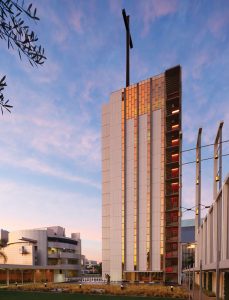Performance-Based Retrofit of a Mid-Century Masterpiece
LPA, Inc. was an Award Winner for its Christ Cathedral Tower of Hope Seismic Retrofit project in the 2016 NCSEA Annual Excellence in Structural Engineering Awards Program in the Category – Renovation/Rehabilitation.
This is the story of a prominent piece of architectural history saved from the wrecking ball and the fusion of art and science that made it possible.
Built in 1968, the Christ Cathedral Tower of Hope has been an important Southern California landmark for almost fifty years. Designed by celebrated architect Richard Neutra, one of the titans of the mid-century modernist movement, the 13-story cast-in-place concrete tower has been called “an overlooked masterwork in Neutra’s oeuvre” by architectural historian Barbara Lamprecht. Once the tallest building in Orange County, the structure is notable for its small but daylight-rich floor plates and vertigo-inducing cantilevered, post-tensioned exterior concrete stairs. The primary structural frame of the tower consists of concrete slabs and beams, supported by rectangular and trapezoidal board-formed concrete columns.
In 2012, the Roman Catholic Diocese of Orange purchased the landmark Crystal Cathedral campus in Garden Grove, California, to serve as its long-planned diocesan cathedral and promptly renamed it Christ Cathedral. From the beginning, the fate of the Tower of Hope was in doubt. A seismic assessment suggested that it was the most vulnerable building on the Cathedral campus because of the limited ductility of the concrete moment frames that form the tower’s primary seismic force resisting system.
Like many concrete buildings built prior to the mid-1970s, the Tower of Hope is susceptible to severe damage or even collapse during a large earthquake due to the lack of ductile steel reinforcing in the moment frame beams and columns. While the Diocese recognized the Tower’s architectural and cultural significance, the safety of its large parish population had to take precedence. It was at this point that contingency plans were made to demolish the iconic building.
The Diocese’s desire to save the building was made even more challenging by the very small floor plates and the need to respect the signature inside-outside connectivity of Neutra’s original design. The renovation design team was challenged to significantly improve seismic performance while not altering the historic lobby, or the famous glass-enclosed “Chapel in the Sky.” A traditional seismic retrofit would necessarily impact the historic fabric throughout all levels of the structure and necessitate significant new construction on the ground floor, extinguishing the fluid, airy character of the glass-walled lobby.
In the Spring of 2013, after several schemes involving new shear walls, braced frames, and foundations proved infeasible, a non-traditional retrofit approach was considered: performance-based design. Instead of disregarding the strength of the existing concrete frames because they did not satisfy the prescriptive detailing requirements of modern building codes, seismic forces would be dissipated passively, allowing the existing concrete frames to resist dramatically reduced demands safely. This approach would use a non-linear time-history analysis to demonstrate that the concrete frames would remain nearly elastic during a 475-year return period earthquake.
Two seismic retrofit strategies were combined to provide life-safety performance without impacting the historic architecture of the building or reducing the usable floor space. First, fluid viscous dampers in a two-story X configuration were installed on floors two through five to reduce the demands on the existing concrete frames. Where the damped demand remained higher than the capacity of the original columns, the columns were strengthened with carbon-fiber-reinforced polymer. Because of its thin profile and high strength, the fiber-wrap allowed for the strengthened columns to be clad with finishes appropriate to the building’s period of architectural significance.
One of the inherent challenges of this retrofit strategy was developing high damper forces into the existing concrete frames. Extensive ground-penetrating radar scanning was performed to locate the existing rebar accurately. Each new connection was individually designed with customized bolt patterns so that through-bolts and expansion anchors could be placed without damaging the existing rebar. In cases where damage to column ties could not be avoided, confining fiber-wrap was added around the perimeter of the column beneath the damper connection plates. The performance-based design strategy limited major construction activities to four of the tower’s thirteen floors, which proved to be far more efficient and less disruptive than a traditional retrofit strategy.
In tandem with architectural and mechanical modernization and the restoration of the iconic lobby and 13th-floor chapel in the sky, the total project cost came to just over $6 million. The success of the seismic retrofit portion of the project led Diocesan representative Rob Neal to comment “LPA took the time to better understand our requirements and needs, resulting in an innovative and elegant solution that preserved the historic architecture of the tower and saved us almost $3 million in construction cost.”
Over the fifty-year lifespan of the Tower of Hope, the practices of architectural design and structural engineering have drifted from their historical unity leaving each profession worse for the parting. The salvation of the Tower of Hope is the result of a 21st-century design team recreating the deliberate synthesis of art and science that is at the heart of Richard Neutra’s mid-20th century modernist design.▪

